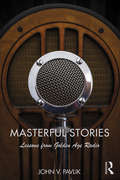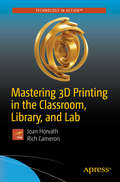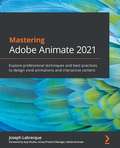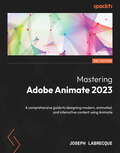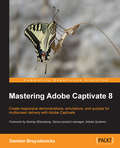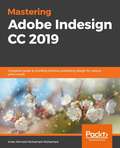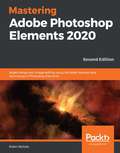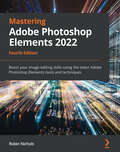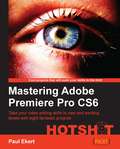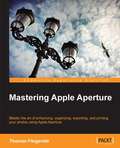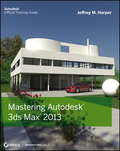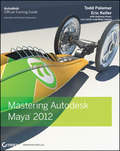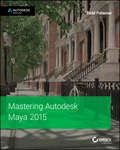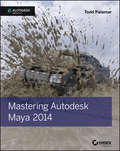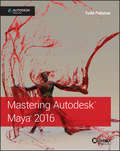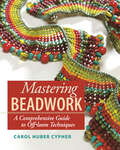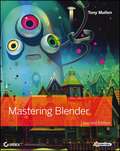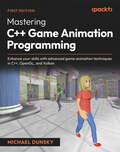- Table View
- List View
Masterful Stories: Lessons from Golden Age Radio
by John V PavlikThe early eras of radio storytelling have entered and continue to enter the public domain in large quantities, offering unprecedented access to the Golden Age of Radio. Author and Professor John Pavlik mines the best this age of radio has to offer in Masterful Stories, an examination of the masterpieces of audio storytelling. This book provides a chronological history of the best of the best from radio’s Golden Age, outlining a core set of principles and techniques that made these radio plays enduring examples of storytelling. It suggests that, by using these techniques, stories can engage audiences emotionally and intellectually. Grounded in a historical and theoretical understanding of radio drama, this volume illuminates the foundational works that proceeded popular modern shows such as Radiolab, The Moth, and Serial. Masterful Stories will be a powerful resource in both media history courses and courses teaching audio storytelling for modern radio and other audio formats, such as podcasting. It will appeal to audio fans looking to learn about and understand the early days of radio drama.
Mastering 3D Printing in the Classroom, Library, and Lab
by Joan Horvath Rich CameronLearn how to manage and integrate the technology of 3D printers in the classroom, library, and lab. With this book, the authors give practical, lessons-learned advice about the nuts and bolts of what happens when you mix 3D printers, teachers, students, and the general public in environments ranging from K-12 and university classrooms to libraries, museums, and after-school community programs.Take your existing programs to the next level with Mastering 3D Printing in the Classroom, Library, and Lab. Organized in a way that is readable and easy to understand, this book is your guide to the many technology options available now in both software and hardware, as well as a compendium of practical use cases and a discussion of how to create experiences that will align with curriculum standards. You'll examine the whole range of working with a 3D printer, from purchase decision to curriculum design. Finally this book points you forward to the digital-fabrication future current students will face, discussing how key skills can be taught as cost-effectively as possible.What You’ll LearnDiscover what is really involved with using a 3D printer in a classroom, library, lab, or public spaceReview use cases of 3D printers designed to enhance student learning and to make practical parts, from elementary school through university research labLook at career-planning directions in the emerging digital fabrication arenaWork with updated tools, hardware, and software for 3D printingWho This Book Is ForEducators of all levels, both formal (classroom) and informal (after-school programs, libraries, museums).
Mastering Adobe Animate 2021: Explore professional techniques and best practices to design vivid animations and interactive content
by Joseph Labrecque Ajay ShuklaStep into the world of animation and go beyond the fundamentals of Adobe Animate to bring experiences to life through expert-led contentKey FeaturesProduce rich motion graphics and interactive animations for multiple platforms and discover different ways to use AnimateExplore the key features and enhancements in the latest Adobe Animate releaseTake your Adobe Animate projects to the next level by delving into creative workflowsBook DescriptionAdobe Animate is platform-agnostic asset creation, motion design, animation, and interactivity software. Complete with step-by-step explanations of essential concepts, practical examples, and hands-on walkthroughs, this book shows you how to use Adobe Animate to create immersive experiences by breaking through creative limitations across every medium. You will begin by getting up to speed with what you need to know about Adobe Animate quickly. Next, you will learn how to get started with Animate as a creative platform and explore the features introduced in the most recent version of the software. Moving on, you'll consume and produce media assets for multiple platforms through both the publish and export workflows. Following this, you'll delve into advanced rigging techniques and discover how to create more dynamic animation with advanced depth and movement techniques. You'll also find out how to build projects such as games, virtual reality experiences, and apps for various platforms. The book concludes with an examination of different methods used to extend the software for various needs. By the end of this book, you'll be able to produce a variety of media assets, motion design materials and animated artifacts, and interactive content pieces - all while targeting a variety of platforms including HTML5 Canvas, WebGL, and mobile devices.What you will learnGain a solid understanding of Adobe Animate foundations and new featuresUnderstand the nuances associated with publishing and exporting rich media content for various platformsMake use of advanced layering and rigging techniques to create engaging motion contentCreate dynamic motion by using the camera and variable layer depth techniquesDevelop web-based games, virtual reality experiences, and multiplatform mobile applicationsExtend Animate with extensions, application-level scripting, and the creation of custom integrated tutorialsWho this book is forThis book is for web, graphic, and motion design professionals with basic experience in animation who want to take their existing skills to the next level. A clear understanding of basic animation concepts will help you to get the most out of this book and produce impressive results.
Mastering Adobe Animate 2023: A comprehensive guide to designing modern, animated, and interactive content using Animate, 3rd Edition
by Joseph LabrecqueBecome an accomplished motion designer, animator, and interactive content producer with the help of expert-led materialKey FeaturesProduce rich motion graphics and interactive animations for multiple platforms by exploring the Adobe Animate ecosystemGet acquainted with the key features and enhancements in the latest Adobe Animate release such as depth, layering, and object warpingTake your Adobe Animate projects to the next level with creative workflows using diverse animation techniquesBook DescriptionAdobe Animate is a platform-agnostic asset creation application that enables you to create motion design and vector animations while facilitating interactivity across other Adobe software such as After Effects, Photoshop, and Illustrator. This book comes packed with explanations of essential concepts and step-by-step walk-throughs of practical examples, guiding you in using Animate to create immersive experiences and breaking the walls of creative limitations.In this third edition, you'll begin by getting up to speed with the features of Adobe Animate. You'll learn how to set up Animate as a creative platform and explore the enhancements introduced in its most recent versions. The book will show you how to consume and produce media assets for different platforms through the publish and export workflows. You'll explore advanced rigging workflows and discover how to create more dynamic animations with complex depth and movement techniques. As the book demonstrates different ways of channeling your creativity through Animate, you'll be able to build projects such as games, virtual reality experiences, generative art, and apps for various platforms. Finally, this graphic design book covers the different methods used to extend the software to meet various user requirements.By the end of this book, you'll be able to produce a variety of media assets, motion graphic designs, animated artifacts, and interactive content pieces for platforms such as HTML5 Canvas, WebGL, and mobile devices.What you will learnGain an understanding of Adobe Animate foundations and new featuresUnderstand how to publish and export rich media content to various platformsFind out how to use advanced layering and rigging techniques to create engaging motion contentExplore how to create dynamic motions using variable layer depth techniquesDevelop web-based games, generative art, virtual reality experiences, and multiplatform mobile applicationsMake the most of Animate with extensions, application-level scripting, and the creation of custom-integrated tutorialsWho this book is forThis book is for web, graphic, and motion design professionals with basic experience in animation who want to take their existing skills to the next level. A clear understanding of fundamental animation concepts will help you to get the most out of this book and produce impressive results.
Mastering Adobe Captivate 2017 - Fourth Edition
by Damien Bruyndonckx Dr Pooja JaisinghCreate responsive SCORM-compliant quizzes, demonstrations, and eLearning content that fit on any device. About This Book • Create highly engaging interactive eLearning content with Adobe Captivate • Create SCORM-compliant Quizzes and host them in your favorite LMS • Make your eLearning content look great on any device with the advanced Responsive features of Adobe Captivate Who This Book Is For If you are a teacher, instructional designer, eLearning developer, or human resources manager and want to implement eLearning, then this book is for you. A basic knowledge of your OS is all it takes to create the next generation of responsive eLearning content. What You Will Learn • Learn how to use features and objects in Adobe Captivate • Drive engagement by adding interactivity to your eLearning content • Add multimedia elements, such as audio and video, to create engaging, state–of-the-art learning experiences • Use themes to craft a unique visual experience that reinforces the learning process • Capture on-screen action and create highly engaging interactive software demonstrations and simulations • Use question slides to create SCORM-compliant quizzes and surveys that integrate seamlessly with your favorite LMS • Make your content look awesome on any device with the advanced responsive features of Captivate • Integrate Captivate with other applications (such as PowerPoint and Photoshop) to establish a professional eLearning production workflow. • Unleash the true power of Captivate with variables and advanced actions In Detail Adobe Captivate is used to create highly engaging, interactive, and responsive eLearning content. This book gives you the expertise you need to reinforce your own professional-quality eLearning course modules. The book takes you through the production of three pieces of eLearning content. First, you will learn how to create a typical interactive Captivate project. This will give you the opportunity to review all Captivate objects one by one and uncover the application's main tools. Then, you will use the built-in capture engine of Captivate to create an interactive software simulation and a Video Demo that can be uploaded to your YouTube channel or published as an MP4 video. Finally, you will approach the advanced responsive features of Captivate to create a project that can be viewed on any device. At the end of the book, you will empower your workflow and projects with the most advanced features of the application, including variables, advanced actions, using Captivate with other applications, and more. This book is an advanced tutorial, containing all the assets required to build its sample projects. Self-exploration is encouraged through extra exercises, experimentation, and external references. Style and approach A step-by-step approach to mastering the latest concepts and features of Adobe Captivate 2017
Mastering Adobe Captivate 2019: Build cutting edge professional SCORM compliant and interactive eLearning content with Adobe Captivate, 5th Edition
by Damien Bruyndonckx Dr Pooja JaisinghCreate responsive eLearning content, including quizzes, demonstrations, simulations and Virtual Reality projects that fit on any device with Adobe Captivate 2019 Key Features Build responsive, interactive and highly engaging eLearning content with Adobe Captivate 2019 Build Virtual Reality eLearning experiences with Adobe Captivate 2019 Assess your student knowledge with interactive and random quizzes Seamlessly integrate your eLearning content with any SCORM or xAPI compliant LMS Book Description Adobe Captivate is used to create highly engaging, interactive, and responsive eLearning content. This book takes you through the production of a few pieces of eLearning content, covering all the project types and workflows of Adobe Captivate. First, you will learn how to create a typical interactive Captivate project. This will give you the opportunity to review all Captivate objects and uncover the application's main tools. Then, you will use the built-in capture engine of Captivate to create an interactive software simulation and a Video Demo that can be published as an MP4 video. Then, you will approach the advanced responsive features of Captivate to create a project that can be viewed on any device. And finally, you will immerse your learners in a 360o environment by creating Virtual Reality projects of Adobe Captivate. At the end of the book, you will empower your workflow and projects with the newer and most advanced features of the application, including variables, advanced actions, JavaScript, and using Captivate 2019 with other applications. If you want to produce high quality eLearning content using a wide variety of techniques, implement eLearning in your company, enable eLearning on any device, assess the effectiveness of the learning by using extensive Quizzing features, or are simply interested in eLearning, this book has you covered! What you will learn Learn how to use the objects in Captivate to build professional eLearning content Enhance your projects by adding interactivity, animations, and more Add multimedia elements, such as audio and video, to create engaging learning experiences Use themes to craft a unique visual experience Use question slides to create SCORM-compliant quizzes that integrate seamlessly with your LMS Make your content fit any device with responsive features of Captivate Create immersive 360Рexperiences with Virtual Reality projects of Captivate 2019 Integrate Captivate with other applications (such as PowerPoint and Photoshop) to establish a professional eLearning production workflow Publish your project in a wide variety of formats including HTML5 and Flash Who this book is for If you are a teacher, instructional designer, eLearning developer, or human resources manager who wants to implement eLearning, then this book is for you. A basic knowledge of your OS is all it takes to create the next generation of responsive eLearning content.
Mastering Adobe Captivate 7
by Damien BruyndonckxA comprehensive tutorial packed with examples, which is divided into small subtopics that follows a clear and logical outline to help you get to grips with Adobe Captivate 7. Readers are also encouraged to develop their understanding of the tool through practical exercises and experimentations in every chapter. A lot of external references and tips and tricks from established e-Learning professionals are also included. If you are a designer, e-Learning developer, or webmaster who wants to construct an interactive and fun-filled e-Learning project using Adobe Captivate 7, this book is ideal for you. Just a basic knowledge of operating system is expected from the developers interested in this book.
Mastering Adobe InDesign 2020: Complete guide to taking your digital design skills from beginner to professional
by Iman Ahmed MohamedMake the most out of Adobe InDesign using this practical guide, filled with design examples and useful techniques Key Features Step-by-step guide, in full color, from planning the design project to generating the desired output for web and print Create engaging design solutions for print media such as posters, magazines, books, and brochures Discover InDesign tips and tricks to increase productivity and simplify the design process Book Description InDesign is not just a tool, but a rich application that will inspire you to transfer your ideas into digital designs. This guide will help you understand the design process and get to grips with application tools and design concepts. This InDesign book starts by taking you through the design process, helping you to think like a designer, and introducing you to the significant features of the InDesign workspace. You'll learn about core Adobe InDesign elements such as pages, guides, and document navigation. You'll then advance to creating, resizing, rearranging, and deleting various design aspects. The book will guide you through setting up Master pages, applying them to pages, adding content, and overriding Master pages content in document pages for a more flexible design process. Finally, you'll explore options for working with text, such as text flow, text frame options, spell checks, and tables. By the end of the book, you'll be up to speed with using InDesign to build design projects for different mediums and publishing effective designs with expert tips and tricks. What you will learn Discover Adobe InDesign's core functions and tools to enhance your designs for pages, books, and magazines Use InDesign features such as Layers and Groups to organize content Build a complete design project by applying different InDesign techniques Store design elements using the InDesign library and the Adobe Creative Cloud library Create and edit documents using the Master Page feature in InDesign Explore various options for working with images, shapes, text, tables, and colors to enhance your designs Who this book is for This InDesign 2020 book is for professionals, non-designers, and anyone who wants to use the InDesign software for creating designs for books, magazines, and pamphlets. Intermediate-level InDesign users who want to enhance their InDesign skills will also find this book useful. The book does not assume any prior knowledge of design tools or techniques.
Mastering Adobe Photoshop Elements 2020: Supercharge your image editing using the latest features and techniques in Photoshop Elements, 2nd Edition
by Robin NicholsAn example-driven guide to take your image editing skills from beginner to advanced using powerful Photoshop Elements tools and techniques in tandem with Adobe's latest AI technology Key Features Updated to the latest version of Photoshop Elements 2020 with focused coverage on Adobe's latest AI technology Organize, search, and keep track of an ever-increasing number of images and videos using expert practices Discover common solutions to a wide range of photographic and image-editing problems Book Description Adobe Photoshop Elements is a raster graphics editor for entry-level photographers, image editors, and hobbyists. Updated and improved to cover the latest features of Photoshop Elements 2020, this second edition includes focused coverage of Adobe's new AI-powered features that are designed to make the editing process more efficient, creative and fun. This book takes you through the complexities of image editing in easy-to-follow, bite-sized chunks, helping you to quickly recognize the editing challenge at hand and use suitable tools and techniques to overcome it. You'll start by learning how to import, organize, manage, edit, and use your pictures in a format that's designed for creative photography projects. Throughout this Adobe Photoshop Elements book, you'll discover how to fix different photographic problems using an extensive repertoire of commonly applied solutions. Common processes such as applying artistic effects to creative projects, custom image makeovers, processing images for social media, and other file export methods will also be covered. By the end of this book, you'll have learned about the impressive tools available in Photoshop Elements 2020, and how it is designed not only for photographers who'd like to dip their toes into the editing world, but also for those wanting simple but effective ideas on how to expand their creativity while remaining time-efficient. What you will learn Explore the automatic AI-powered features designed to make the editing process faster and more efficient Add graphic elements to any composition, photograph, or illustration Overcome challenges in editing multi-layered images for your photography projects Develop illustrative skills using Photoshop Elements' drawing tools Learn techniques for professional photo retouching Work with online and local templates to create calendars, greeting cards, and other projects Who this book is for This book is for creative and enthusiastic photographers with elementary experience in photo editing. If you are looking to organize your picture collection and take control of post-processing requirements, you'll find this book useful. Though not necessary, photography skills alongside basic photo editing knowledge will help you to get the most out of this book.
Mastering Adobe Photoshop Elements 2021: Boost your image-editing skills using the latest tools and techniques in Adobe Photoshop Elements, 3rd Edition
by Robin NicholsLeverage this well-illustrated, easy-to-understand end-to-end guide to become an accomplished photo editor, image retoucher, and creative artistKey FeaturesUpdated to the latest version of Photoshop Elements 2021 with focused coverage of Adobe's latest AI technologyOrganize, search, and manage an ever-increasing number of images and videos using expert practicesUncover common solutions to a wide range of photographic and image-editing problemsBook DescriptionManaging thousands of images while producing perfectly edited results is now a must-have skill for online bloggers, influencers, vloggers, social media users, and photography enthusiasts. Photoshop Elements helps you to manage this easily and boost your creative output. This third edition is updated with Elements 2021's latest features and focuses on Adobe's AI-powered features along with the entire creative workflow. Each chapter is designed to help you get the most out of your image files in an easy way. You'll learn how to add significant visual improvements to your work using no more than a few one-click edits with AI-driven features and manual adjustments. The book is filled with useful instructions to guide you seamlessly through the often complex processes, tools, and features in Photoshop Elements. Finally, you'll cover everything from developing your organizational skills through to creating remarkable special effects, complex text, image combinations, and eye-popping visual techniques using both AI-driven features as well as manually operated tools. By the end of this Photoshop Elements book, you'll have learned how to leverage the impressive tools available in Photoshop Elements 2021, and use them to greatly improve your photo editing and image retouching skills.What you will learnIdentify the five parts of Elements and set up your computer, camera, and monitorImport, organize, and keep track of your imported media libraryDevelop advanced image retouching skillsDiscover how to add text and graphics to photographsCultivate your understanding of multi-image, multi-layered editing techniquesDevelop illustrative skills with the many drawing tools available in Elements 2021Prepare images and projects for uploading to social media, print, and videoFind out how to troubleshoot your work when things don't come out the way you hoped they wouldWho this book is forThis book is for amateur photographers looking to dip their toes into the editing world, anyone who wants simple but effective ideas on how to expand their creativity, as well as advanced enthusiasts seeking to push the boundaries of their creative output. Though not necessary, photography skills together with basic photo editing knowledge will help you to get the most out of this book.
Mastering Adobe Photoshop Elements 2022: Boost your image-editing skills using the latest Adobe Photoshop Elements tools and techniques, 4th Edition
by Robin NicholsBecome an accomplished photo editor, image retoucher, or creative artist with this well-illustrated, easy-to-understand, and end-to-end guideKey FeaturesUpdated to the latest version of Photoshop Elements 2022 with focused coverage of Adobe's latest AI technologyOrganize, search, and manage an ever-increasing number of images, videos, and multimedia using expert practicesFind solutions to a wide range of photographic and image-editing problemsBook DescriptionManaging thousands of images while producing perfectly edited results has now become a must-have skill for bloggers, influencers, all social media users, and photography enthusiasts.Photoshop Elements 2022 has all the right tools to help you manage your growing multimedia assets and significantly boost your creative output.This fourth edition is updated with Elements 2022's latest features, including Adobe's AI-powered tools that perfectly complement its entire creative workflow. Each chapter is designed to help you get the most from your image files in a simple, easy-to-follow way. You'll find out how to add significant visual improvements to your projects using brilliant AI-driven single-click edits or through more complex manual adjustments, all depending on your skill level and requirements. The book is packed with clear instructions to guide you effortlessly through the hundreds of processes, tools, and features in Photoshop Elements 2022. You'll cover everything from developing your organizational skills through to creating remarkable images using photos, text, graphics, downloadable content, animation, and a range of fantastic AI-driven features.By the end of this Photoshop Elements book, you'll have learned how to leverage the impressive tools available in Photoshop Elements 2022 with confidence.What you will learnIdentify the five parts of Elements and set up your computer, camera, and color monitor for best resultsImport, organize, and keep track of your imported media libraryAdd impressive visual effects to your work in secondsDevelop advanced picture retouching skillsDiscover how to add text and graphic elementsCultivate your understanding of multi-image and multi-layered editing techniquesDevelop illustrative skills using the many drawing and design toolsFind out how to troubleshoot your work when things don't come out the way you hoped they wouldWho this book is forThis Photoshop Elements book is for creative and enthusiastic photographers who have elementary experience in photo editing. If you are looking to organize your picture collection, make simple yet effective edits, and take control of post-processing requirements, you'll find this book useful.
Mastering Adobe Photoshop Elements 2023: Bring out the best in your images using Adobe Photoshop Elements 2023, 5th Edition
by Robin NicholsTake complete control of all your image-editing ambitions using this beautifully illustrated, easy-to-understand, jargon-free guidePurchase of the print or Kindle book includes a free eBook in PDF formatKey FeaturesFifth edition of the bestselling, widely acclaimed Photoshop Elements seriesClear instructions, color images, hundreds of examples to demonstrate features in Adobe Elements 2023Fully updated to include advanced Layer Masking and Retouching techniques, Photo Bashing, scrapbooking, plug-ins and a range of impressive features driven by Adobe Sensei AI technologyBook DescriptionProduce impressive, high-quality pictures to influence your audience, grow your brand, and market your products and services.With its impressive range of sophisticated creative capabilities, Adobe Photoshop Elements 2023 is all you need to create photos you'll love to share.The fifth edition of this widely acclaimed series will help you master photo-editing from scratch. Start by learning basic edits such as auto tone correction, image resizing and cropping, then master contrast, color, sharpness, and clarity.If you're stuck, check out the new chapter 'Getting Started with Simple Solutions' where your most common questions are answered.Elements 2023 extends its AI capabilities by simplifying complex editing processes. Learn to stitch widescreen panoramas, remove people from backgrounds, de-focus backgrounds, re-compose images, and even create a range of calendars and greeting cards for your friends and family.Take your prowess to the next level by learning how to correct optical distortion, re-shape images, exploit layers, layer masking, and sharpening techniques—create the perfect picture or imaginative fantasy illustration. You'll also learn the online realms of animation, video creation, and third-party plug-ins.By the end of this book, you'll learn how to leverage the incredible features of Photoshop Elements 2023 with complete confidence.What you will learnHow to retouch images professionally, replace backgrounds, remove people, and resize your imagesAnimate parts of your photos to create memes to wow your social media fansShowcase your photos and videos with all-new collage and slideshow templatesUse image overlays to create unique depth of field effectsDiscover advanced layer techniques designed to create immersive and powerful illustrationsTake your selection skills to the next level for the ultimate in image controlDevelop your illustration skills using the power of Elements' huge range of graphics tools and featuresEasily create wonderful effects using Adobe's awesome AI technologyWho this book is forThis Photoshop Elements book is for creative and enthusiastic photographers who have elementary experience in photo editing. If you are looking to organize your picture collection, make simple yet effective edits, and take control of post-processing requirements, this is the book for you
Mastering Adobe Photoshop Elements: Bring out the best in your images using Adobe Photoshop Elements 2024
by Robin NicholsTake complete control of your image-editing process with this beautifully illustrated, easy-to-understand, and jargon-free guide to Photoshop Elements 2024Key FeaturesBenefit from comprehensive coverage of Adobe Photoshop Elements 2024, including new AI-powered tools and advanced featuresGet practical guidance on photo organization, editing, and sharing, with an emphasis on creative and professional techniquesLearn through rich, illustrative content with updated examples, tutorials, and mini creative mini projectsPurchase of the print or Kindle book includes a free PDF eBookBook DescriptionDive into the world of digital photo editing with this latest edition, crafted by a seasoned photographer and digital imaging expert, and harness the full potential of the latest Photoshop Elements 2024. With a unique blend of in-depth tutorials and practical applications, this book is an essential resource for photographers at all levels. Alongside introducing new features like Dark Mode, Match Color, and Photo Reels, as well as advanced techniques like layering and artistic effects, this book addresses common user feedback from previous editions, ensuring a refined and user-friendly experience. With the help of this guide, you’ll learn how to leverage AI to stitch widescreen panoramas, remove people from backgrounds, defocus backgrounds, recompose images, and even create a range of calendars and greeting cards for your friends and family. You’ll take your prowess to the next level by learning how to correct optical distortion, reshape images, exploit layers, layer masking, and get to grips with sharpening techniques to create the perfect picture or imaginative fantasy illustration. The online realms of animation, video creation, and third-party plugins will also be covered. By the end of this book, you'll know how to leverage the incredible features of Photoshop Elements 2024 with complete confidence. What you will learnMaster new features in Photoshop Elements 2024, including AI-powered tools and one-click fixes on mobileCreate captivating photo collages, digital paintings, and graphic designsEfficiently organize your photo collections for easy access and managementEnhance your social media presence with professionally edited photos and artworksEmploy advanced layer techniques for more powerful and immersive illustrationsGain comprehensive knowledge to become a proficient Photoshop Elements userWho this book is forMastering Adobe Photoshop Elements, Sixth Edition, is for photographers of all skill levels—from hobbyists to professionals. Whether you are new to photo editing or looking to upgrade your skills with the latest Photoshop Elements features, this book offers valuable insights and guidance.
Mastering Adobe Photoshop Elements: Excel in digital photography and image editing for print and web using Photoshop Elements 2019
by Robin NicholsBecome a professional photo editor and bring your ideas to life with Photoshop Elements 2019 Key Features Improve your pictures with easy-to-follow techniques that help you make simple, fast and effective edits Understand how to animate and add multiple layers to your images Master the Photoshop Elements user interface (UI) with real-life examples Book Description Adobe Photoshop Elements is a raster graphics editor for entry-level photographers, image editors, and hobbyists. Though it shares many of Photoshop CC's high-end features, it also boasts a significant number of simple to use, yet highly effective tools not found at the professional level. This book presents the complexities of image editing in easy-to-follow, bite-sized chunks, allowing you to quickly recognize the editing challenge, and helps you to identify the tools and techniques required to make improvements, and to apply those techniques quickly and efficiently. You will start by learning how to import, organize, manage, edit, and use your pictures in a format that's designed for creative photography projects. Going further, you'll discover how to fix a wide range of photographic problems based on the book's extensive repertoire of commonly applied solutions. You'll be escorted through a wide range of common processes that include applying artistic effects to creative projects, custom image makeovers, processing images for social media, and other file export methods. Towards the end of the book, you will understand what the most important tools and features actually do in Photoshop Elements, answering the often-asked question; What, when, and where would you use these features in a precise and practical way. What you will learn Understand the latest Photoshop tools to add life to your photos Add graphic elements to any composition, photograph, or illustration Tackle challenges in editing multi-layered images for your photography projects Develop illustrative skills with Photoshop Elements' variety of drawing tools Understand techniques for professional photo retouching Work with online and local templates to create calendars, greeting cards, and other projects Who this book is for This book is for photographers, creative professionals, and individuals who want to master image editing for publishing, press, and web formats with Adobe's Photoshop Elements. Professionals who are looking to become accomplished image retouchers will also find the book helpful. Photography skills along with basic photo editing knowledge will be useful, but not necessary.
Mastering Adobe Premiere Pro CS6 Hotshot
by Paul EkertDesigned to be practical and engaging, Mastering Adobe Premiere Pro CS6 is a project-based book to help you truly augment your skills and become a film editing hotshot.If you're just starting out or even migrating from existing video editing software, then this book is for you. With rapid progression through practical examples constructed to be both engaging and useful, Mastering Adobe Premiere Pro CS6 is ideal for learning the sometimes complex workflows of this powerful application.
Mastering Apple Aperture
by Thomas FitzgeraldWritten in a conversational style, the author will share his knowledge on advanced Aperture topics with detailed discussions of advanced topics, the theory behind some of those topics and lots of hints and tips for ways to improve your workflow.Photographer's who have a basic understanding of Aperture
Mastering Autodesk 3ds Max 2013
by Jeffrey HarperGet professional training in 3ds Max from this Autodesk Official Training Guide Extremely popular with video game designers as well as architects, 3ds Max offers integrated 3D modeling, animation, rendering, and compositing tools designed to streamline production. If you already have a working knowledge of 3ds Max basics, this official guide will take your skills to the next level. Detailed tutorials cover all the latest features of 3ds Max. From modeling, texturing, animation, and architectural visualization to high-level techniques for film, television, games, and more, this book provides professional-level instruction on 3ds Max. Those who are proficient in 3ds Max basics can take their 3D animation skills to the next level with this Autodesk Official Training Guide Offers industry-level training, with diverse tutorials that showcase techniques used in actual animations for games, film, TV, and architectural visualization Covers modeling, texturing, animation, visual effects, and high-level techniques as well as all the latest features of 3ds Max Also recommended as a preparation guide to Autodesk's 3ds Max Associate and Professional exams Mastering Autodesk 3ds Max will help intermediate to advanced 3ds Max users develop and sharpen their skills in this popular animation and effects software.
Mastering Autodesk Maya 2012
by Todd Palamar Eric KellerThe exclusive, official guide to the very latest version of MayaGet extensive, hands-on, intermediate to advanced coverage of Autodesk Maya 2012, the top-selling 3D software on the market. If you already know Maya basics, this authoritative book takes you to the next level. From modeling, texturing, animation, and visual effects to high-level techniques for film, television, games, and more, this book provides professional-level Maya instruction. With pages of scenarios and examples from some of the leading professionals in the industry, author Todd Palamar will help you master the entire CG production pipeline.Provides professional-level instruction on Maya, the industry-leading 3D animation and effects software used in popular films, games, and commercialsCovers the very latest Maya 2012 tools and features, including the new fluid simulation toolsShowcases the techniques of professionals through numerous examples, demonstrating how to set up and manage 3D animation and visual effects pipelinesIncludes challenging tutorials and real-world scenarios from some of the leading professionals in the industryIf you're looking for an in-depth, professional Maya resource to turn to again and again, this is the book you need.
Mastering Autodesk Maya 2014
by Todd PalamarHands-on intermediate-to-advanced coverage of the leading 3DsoftwareAutodesk Maya is the industry-leading 3D animation and effectssoftware used in movies, visual effects, games, and other genres.If you already know the basics of Maya and are ready to elevateyour skills, then this book is for you. Nearly 1,000 pages arepacked with organized, professional, and valuable insight on theleading 3D application on the market, enabling you to unlock thesoftware's more complex features. Ideal as both a tutorial andstudy guide for the Autodesk Maya exam, this Autodesk OfficialPress book gets you up to speed on Maya's latest features andexpands your skills with advanced instruction on cloth, fur, andfluids.Features challenging tutorials and real-world scenarios fromsome of the leading professionals in the industryProvides you with valuable insight into the entire CGproduction pipelineCovers the very latest Maya 2014 tools and features, includingupdates to dynamics, Maya muscle, stereo cameras, assets, renderingwith mental ray, and moreHelps you gain proficiency in high-level techniques for film,television, game development, and moreIf you've been looking for a complete, professional quality Mayaresource to turn to again and again, look no further thanMastering Autodesk Maya 2104.
Mastering Autodesk Maya 2014: Autodesk Official Press
by Todd PalamarHands-on intermediate-to-advanced coverage of the leading 3D software Autodesk Maya is the industry-leading 3D animation and effects software used in movies, visual effects, games, and other genres. If you already know the basics of Maya and are ready to elevate your skills, then this book is for you. Nearly 1,000 pages are packed with organized, professional, and valuable insight on the leading 3D application on the market, enabling you to unlock the software's more complex features. Ideal as both a tutorial and study guide for the Autodesk Maya exam, this Autodesk Official Press book gets you up to speed on Maya's latest features and expands your skills with advanced instruction on cloth, fur, and fluids. Features challenging tutorials and real-world scenarios from some of the leading professionals in the industry Provides you with valuable insight into the entire CG production pipeline Covers the very latest Maya 2014 tools and features, including updates to dynamics, Maya muscle, stereo cameras, assets, rendering with mental ray, and more Helps you gain proficiency in high-level techniques for film, television, game development, and more If you've been looking for a complete, professional quality Maya resource to turn to again and again, look no further than Mastering Autodesk Maya 2104.
Mastering Autodesk Maya 2016: Autodesk Official Press
by Todd PalamarGo from 'beginner' to 'expert' with this professional, tutorial-based guide to Maya 2016 Mastering Autodesk Maya 2016 is your professional hands-on coverage to getting the most out of Maya. If you already know the basics of Maya, this book is your ticket to full coverage of all Maya 2016's latest features, and showcases the tools and methods used in real-world 3D animation and visual effects. From modeling, texturing, animation, and effects to high-level techniques for film, television, games, and more, this book expands your skill set, and helps you prepare for the Autodesk Maya certification exam. Filled with challenging tutorials and real-world scenarios this book provides valuable insight into the entire CG production timeline. Take your Maya skills to the next level with step-by-step instruction and insight from the industry professionals. Learn professional techniques used in real-world visual effects Master Dynamics, Maya Muscle, Stereo Cameras, mental ray, and more Expand your skills with advanced techniques for cloth, fur, and fluids Understand everything you need to know for the Maya certification exam
Mastering Beadwork: A Comprehensive Guide To Off-loom Techniques
by Carol Huber CypherAre you a new beader seeking solid beading foundations? Or are you an experienced beadworker wanting to refine your skills? Mastering Beadwork is your ultimate resource for beading knowledge-it's a project book plus reference tool wrapped up in one.Based on years of teaching experience, Carol Cypher presents easy-to-understand instructions with informative sidebars to help anyone master beading techniques. Each of the 13 techniques are explained in detail, then further explored with projects to enhance the beader's skills and confidence. The 63 projects included here-ranging from bracelets, necklaces, rings, and earrings to findings, closures, beaded beads, and other beaded objects-teach a single project or technique but are arranged to build skills at any level. You'll also find suggestions for personalizing and expanding on each project or pattern.Learn all the basic beading stitches-from peyote, spiral, vertical and horizontal netting, bead crochet, right-angle weave, triangle weave, daisy chain, ladder stitch, ndebele, brick stitch, African helix, and more.Mastering Beadwork is a classroom in a book, an all-in-one reference guide, and a compendium of beading techniques. It will supplement what you've already learned in beading classes, set you on the first steps to beading confidence, and infuse your work with inspiration.
Mastering Blender
by Tony MullenNew edition shows you how to get the very most out of the latest version of BlenderBlender, the open-source 3D software, is more popular than ever and continues to add functionality. If you're an intermediate or advanced user, this new edition of Tony Mullen's expert guide is what you need to get up to speed on Blender and expand your skills. From modeling, texturing, animation, and visual effects to high-level techniques for film, television, games, and more, this book covers it all. It also highlights Blender's very latest features, including new camera tracking tools and a new renderer.Provides intermediate to advanced coverage of Blender and its modeling, texturing, animation, and visual effects tools Covers advanced topics such as cloth, fur and fluids, Python scripting, and the Blender game engine Brings you up to speed on Blender's new camera tracking tools and new renderer Showcases techniques used in real-world 3D animation and visual effectsCreate realistic animation and visual effects with Blender and this expert guide that shows you step by step how to do it.
Mastering C++ Game Animation Programming: Enhance your skills with advanced game animation techniques in C++, OpenGL, and Vulkan
by Michael DunskyDevelop a compact game engine–like animation application in C++ using OpenGL 4 or Vulkan through hands-on implementation in this part-color guideKey FeaturesLearn how to build a game engine–like skeleton application using a modern graphics APIExplore compute shaders, visual selection, UI creation, visual programming, configuration file handling, collision detection, behavior controls, and moreCreate your own virtual world with naturally acting inhabitantsPurchase of the print or Kindle book includes a free PDF eBookBook DescriptionWith two decades of programming experience across multiple languages and platforms, expert game developer and console porting programmer Michael Dunsky guides you through the intricacies of character animation programming. This book tackles the common challenges developers face in creating sophisticated, efficient, and visually appealing character animations. You’ll learn how to leverage the Open Asset Import Library for easy 3D model loading and optimize your 3D engine by offloading computations from the CPU to the GPU. The book covers visual selection, extended camera handling, and separating your application into edit and simulation modes. You’ll also master configuration storage to progressively build your virtual world piece by piece. As you develop your engine-like application, you’ll implement collision detection, inverse kinematics, and expert techniques to bring your characters to life with realistic visuals and fluid movement. For more advanced animation and character behavior controls, you’ll design truly immersive and responsive NPCs, load real game maps, and use navigation algorithms, enabling the instances to roam freely in complex environments. By the end of this book, you’ll be skilled at designing interactive virtual worlds inhabited by lifelike NPCs that exhibit natural, context-aware behaviors.What you will learnMaster the basics of the Open Asset Import LibraryAnimate thousands of game charactersExtend ImGui with more advanced control typesImplement simple configuration file handlingExplore collision detection between 3D models and world objectsCombine inverse kinematics and collision detectionWork with state machines, behavior trees, and interactive NPC behaviorsImplement navigation for NPC movement in unknown terrainsWho this book is forThis book is for experienced C++ developers, game programmers, and character animators who already have basic knowledge of character animation but are curious to learn more. The book assumes advanced C++ knowledge and is ideal for those eager to delve into advanced animation techniques and create interactive virtual worlds.
Mastering C++ Game Development: Create professional and realistic 3D games using C++ 17
by Mickey MacdonaldHigh-end game development with advanced C++ 17 programming techniques Key Features Make the best use of object-oriented capabilities of C++ 17 to develop high-end games Create reusable C++ 17 libraries and editor tools for your game Series of example projects demonstrating advanced techniques to build games of any genre Book Description Although many languages are now being used to develop games, C++ remains the standard for professional development. The majority of professional libraries and toolchains are still built using C++. The primary goal of this book is to teach you how to harness the power of the language and provide you with the ability to build high-quality games. To begin, you will be presented with, an overview of popular development methodologies, and a short guide to updated features of the C++ 17 standard. You will learn how to leverage existing libraries such as OpenGL and the STL (standard library) to build complex systems. Throughout the journey, you will also build a set of C++ 17 compatible libraries that can be reused in your own development projects. In the last half of the book, you will work with demos designed to introduce you to advanced rendering techniques, interactive physics, advanced AI techniques, and even multiplayer game concerns with modern networks. What you will learn Work and communicate effectively in the modern games industry Develop simple and advanced gameplay systems How to leverage the standard core C++ libraries Use modern real-time rendering techniques to achieve immersive 3D visuals Achieve a narrative-driven game experience using a variety of data management techniques Implement scripting using LUA Learn AI algorithms and concepts for handling motion, behavior, and decision making Implementation of the OpenGL, Bullet Physics, GLM, SteamVR and other common libraries Who this book is for This book is intended for aspiring game developers who are proficient in C++ 17 programming and are interested in developing professional games with C++.17
